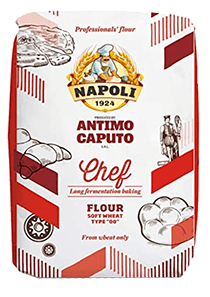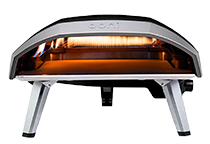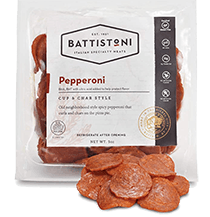Learning to make homemade pizza takes time and practice. Every home chef that starts making pizza will learn from trial and error. It’s easy to make mistakes with homemade pizza when you are just starting out.
Getting the measurements just right for the dough and learning how to best use a pizza stone and pizza peel can be challenging at first, but with a bit of patience, every home chef can become a pizzaiolo.
We had our fair share of kitchen mishaps when we started making homemade pizza, and in the spirit of learning and sharing, we compiled them into a list.
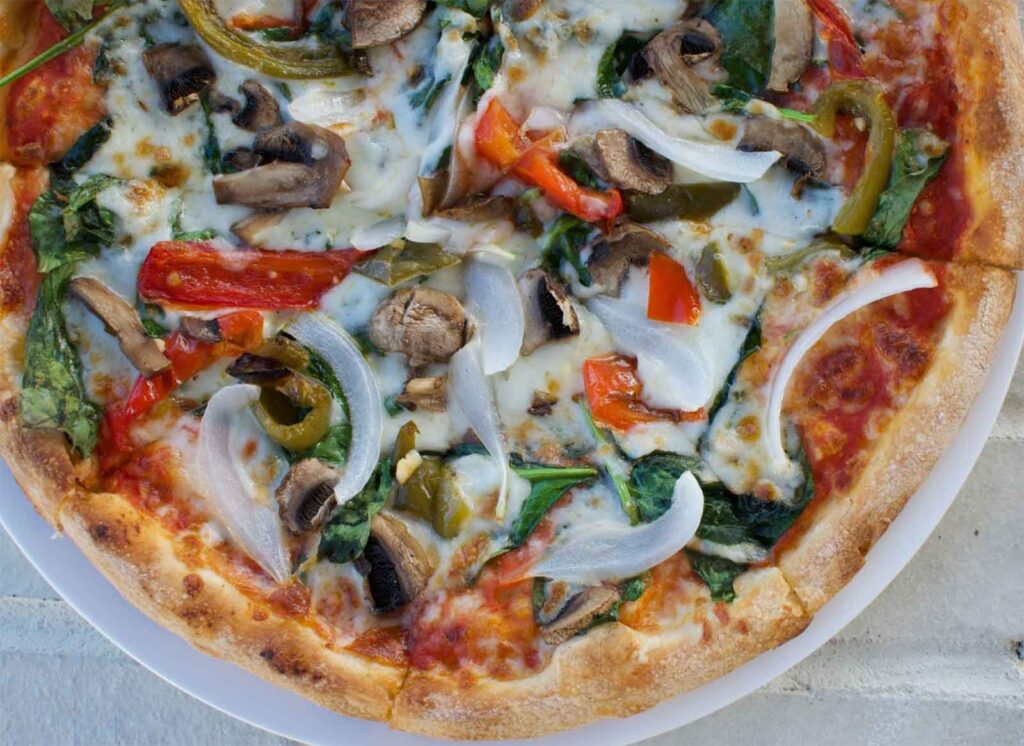
We organized the most common mistakes with homemade pizza into sections for dough, sauce, toppings, baking, and serving to help you find the solutions to all of your queries about how to avoid the pizza pitfalls that every home pizzaiolo makes at the beginning of their pizza making journey.
For further reading on the subject, check out the devil’s 7 deadly sins of homemade pizza that we urge you to never commit. Or else
Mistakes with Homemade Pizza Dough
Type of flour
A good pizza dough recipe starts with good flour. The best flour for pizza making is a high gluten flour because gluten is responsible for the stretching, and you want a light dough that can stretch. In Italy, pizzaiolos swear by the flour called 00 flour.
This flour is very fine, almost like a baby powder. It’s perfect for Neapolitan pizza. If you can’t find 00 flour in your supermarket then using bread flour is the next best thing. Bread flour is also perfect for a New York style.
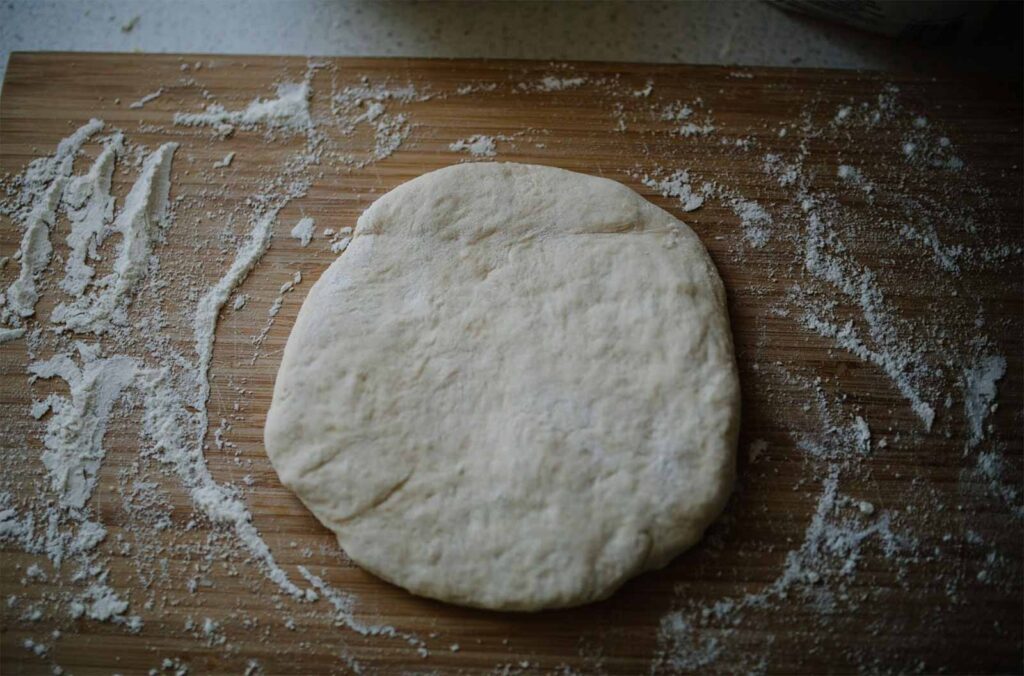
Resting dough
A lot of home chefs are hungry for pizza, and to move the process along, they don’t let the dough rest. The dough always needs to rest before being pulled. If you are making fresh dough then it needs between 2-3 hours to rest and rise.
If you are using store-bought dough or pre-made dough from the fridge or freezer, the dough should rest and warm up before being stretched.
Too much yeast
Ok, so this one is an easy mistake. The yeast packets are small, and one of the common mistakes with homemade pizza is to put in too much yeast. Extra yeast will make a faster rise, but the crust will be bland. Instead, use two teaspoons of rapid-rise yeast and let that slow fermentation process hold.
Flour and yeast first
We learned this from a friend who is a pizzaiolo. The order of the ingredients matter. Start with flour and activated yeast, then add the water slowly, not all at once.
Adding salt
While you do need to add salt to the dough, it should be the last thing added because salt will kill yeast, and it won’t activate. Dead yeast won’t rise, making dense dough.
Over-stretching the dough
You don’t want to overwork or overstretch the dough. Depending on your preference for thick or thin crust, the dough should be stretched to between ¼ of an inch to ⅛ of an inch in thickness.
Mistakes with Homemade Pizza Sauce
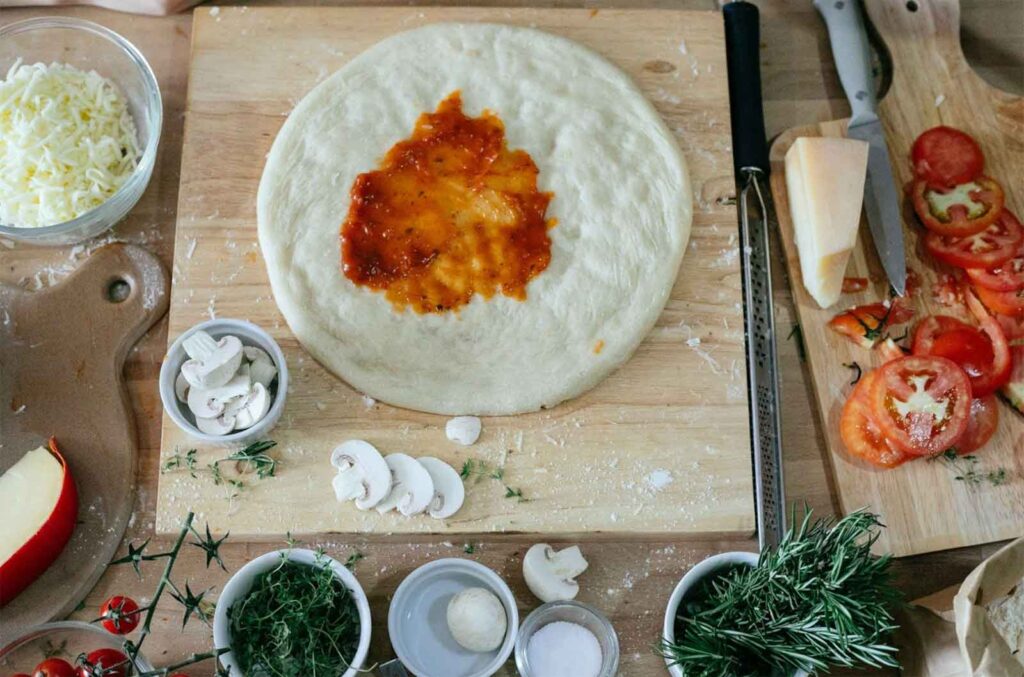
Buying store-bought sauce
Pizza sauce is easy to make, and it can be the difference between a good pizza and an excellent pizza. So always make your own sauce. There are a few different theories on pizza sauce, and it really comes down to taste.
Many pizzaiolos swear by a fresh sauce made with quality canned tomatoes and fresh herbs. Other pizzaiolos cook their sauce for hours on the stove with lots of garlic and herbs. If you aren’t sure what you like, try making both and seeing where your tastes lie.
The good thing about pizza sauce is you can make it in batches and freeze it in reusable storage bags. We love to do this, so we always have some homemade pizza sauce ready when we want a pizza. Time to stop making sauce mistakes with homemade pizza!
Using fresh tomatoes in the winter
You can forgo the canned tomatoes and make pizza sauce with fresh tomatoes. However, this is only a good option if it’s tomato season. So in the summer, hit your local farmers market and stock up on fresh tomatoes to make a sauce.
But in the off-season, stick with canned tomatoes. Off-season tomatoes have a lot of water and minimal flavor, which ruins the sauce.
Forgetting the herbs
Homemade pizza sauce needs some flavorful herbs and spices. Again this is a matter of taste. You can use oregano, basil, thyme, crushed red pepper, salt, and pepper.
We always add lots of garlic and a sprinkle of crushed red pepper, but others prefer less garlic and added heat. Use your favorite herbs and spices, just don’t forget to add them for a memorable sauce.
Mistakes with Homemade Pizza Toppings
Don’t be a slowpoke
It’s important to have all of your toppings cut and ready. Make sure your cheese is grated or sliced. Once the dough is stretched, you have to move quickly when putting it together.
The longer the dough stays on the pizza peel, the more it warms up, making it more likely to stick. So be organized and ready once the dough is ready. You also need to decide if you want to use cornmeal or semolina – they’re a game changer with pizza peels!
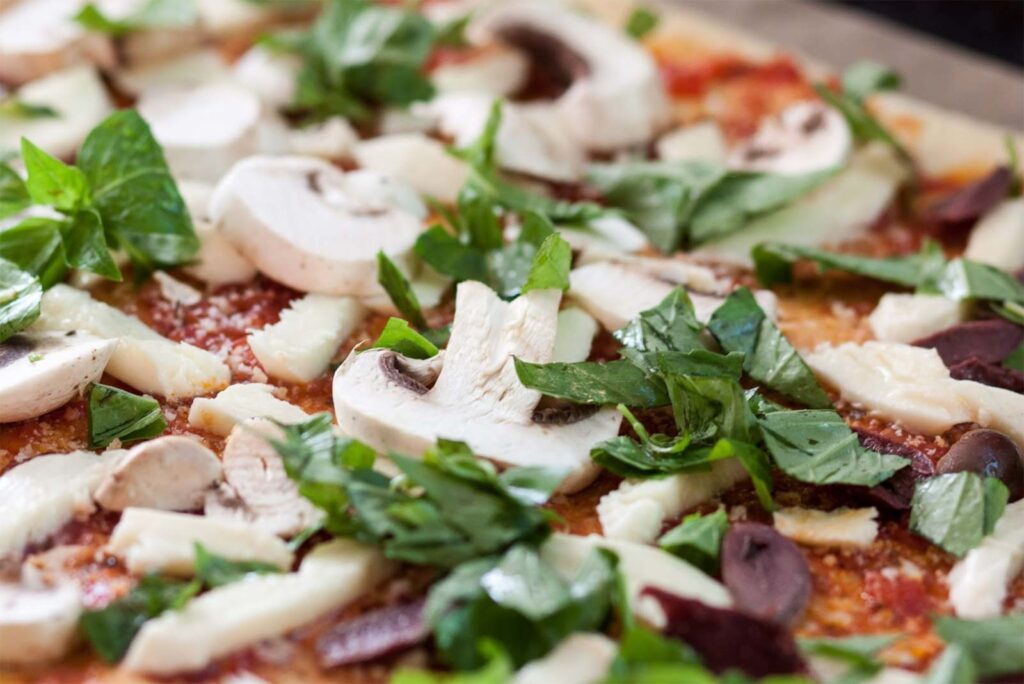
Overloading toppings
While you may love tons of different pizza toppings, you need to be selective about which toppings to use. Too many toppings crowd flavor but also can overload a pizza.
Too cheesy
One of the most common mistakes with homemade pizza is too much cheese. Now don’t get us wrong here. We love cheese, but like all good things, too much of a good thing doesn’t work. It will make the pizza heavy and oily. Pizza can indeed be healthy, but too much cheese can ruin a good pizza.
Avoid pre-shredded cheese
Pre-shredded cheese contains potato starch and natamycin, which keeps it from clumping together, meaning it won’t melt well. You should always choose the best cheese like fresh mozzarella and Parmesano Reggiano and grate it yourself, or better yet, enlist a family member to be the official cheese grater.
Not only will freshly grated cheese melt better and have better flavor, but it’s also better for your pocketbook. Vegans can try nutritional yeast as a cheese substitute.
Precook toppings
If you add Italian sausage, chorizo, ground beef, or shrimp, all of these proteins need to be precooked. Don’t worry about this step for cured meats like salami, prosciutto, or smoked salmon. The same goes for vegetables.
Some vegetables benefit from a little heat prior to being added to a pizza. Sautéing mushrooms, bell peppers, onions, broccoli, spinach, or other veggies helps break them down.
This is especially true if you’re using a pizza oven. Pizza ovens get very hot and quickly cook pizzas without much time for the veggies to cook.
Using wet toppings
Using marinated artichokes, sun-dried tomatoes, olives, pineapple, or anything else that comes wet needs to be dried a bit before going on a pizza. You can just use a paper towel to squeeze out some moisture. Wet toppings will make a soggy pizza.
Baking Mistakes Homemade Pizza
Not cooking long enough
Have you ever bitten into a hot pizza only to realize the dough isn’t fully cooked in the middle? Trust us. It’s gross. And we know because this is one of the mistakes with homemade pizza that we are guilty of making.
So get to know your oven and its highest temperature. Experiment with the rack levels and find the right temperature. Par-baking the crust is one way to avoid this disaster.
Not cooking hot enough
If you are using a conventional oven and you are serious about making good pizza, then you must invest in a pizza stone. Pizza stones hold heat and can keep a steady high temperature to evenly cook a pizza.
There are a lot of different styles and sizes of pizza stones and they are all a good investment. If properly cared for, a pizza stone can last an incredibly long time. You can even use a cast iron pan because those also hold heat well. A baking sheet just doesn’t get and stay hot enough to get a good crust.
Use broil
The broil setting is your friend. Broil can help finish up the pizza. Again, experiment with your oven and see which works best for you. After the pizza is cooked, use broil, which helps finish up the top. This is especially important if you like a well-cooked pizza.
Don’t use parchment paper
Avoid parchment paper with pizza. Parchment paper is great for baked goods but not necessary for pizza. Instead, use a sprinkle of corn flour on your pizza stone to keep it from sticking.
A common mistake is to use flour, and yes, flour will keep it from sticking, but then you have a layer of dry flour on the bottom of your pizza. In contrast, corn flour will keep it from sticking, and it falls off, so you will never get a mouthful of it.
Let it cool
We know you are hungry, and the sight of a hot pizza right out of the oven is enticing, but you need to let the pizza cool before slicing into it. We don’t mean wait till it’s cold. Just give it a second to cool so the cheese can firm up.
If you cut a hot pizza right after it’s cooked, the cheese will slide everywhere, and the toppings will come off. It’s a hot mess. So take a beat and give the pizza a moment before you slice it up.
Stop spying on your pizza
Keep the oven door closed. Resist the temptation to check it and open the oven door. Conventional ovens only get to around 450°or 500° F, so every time you open the door for a little peek at your beautiful cheesy creation, you are messing with the heat, and your pizza baby needs heat.
Cut carefully
Use a pizza cutter to make a clear cut in your pizza. Also, consider who is eating pizza and cut it appropriately. We often have pizza parties with friends and make a few different pies, so we cut smaller pieces so everyone can try a bit of each.
This is especially important when making pizzas with unusual toppings that everyone wants to taste. A proper pizza cutter slices better than just a chopping knife. Practice with your cutters. You can eyeball the right sizes. The best way is to cut the pizza in half and then slice each half separately.
Serving Suggestions for Homemade Pizza
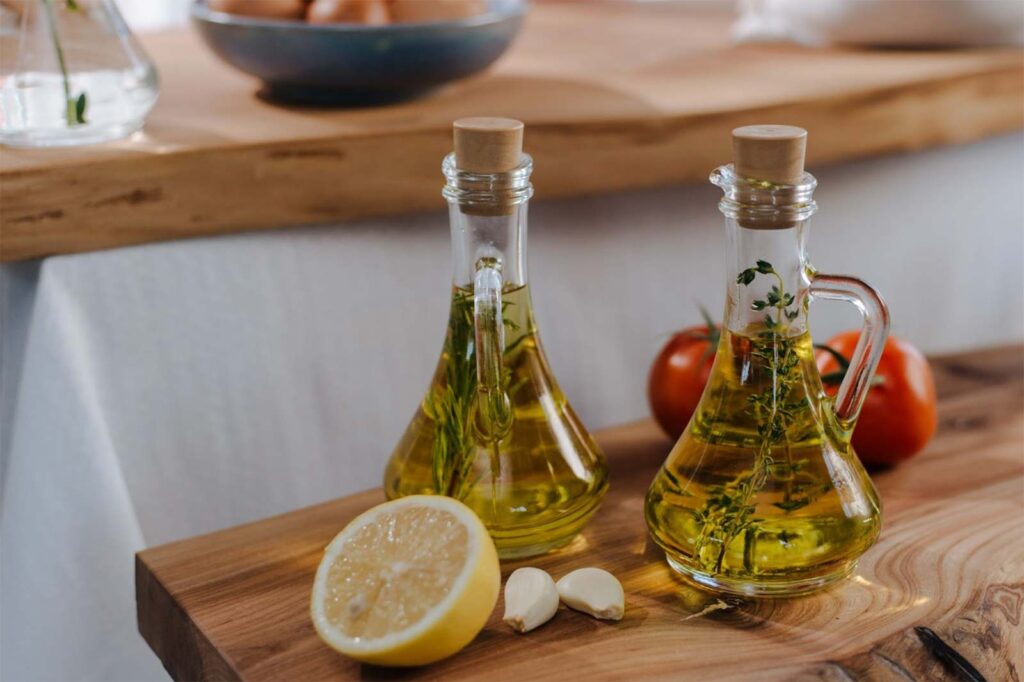
Herb infused oils
Olive oils with herbs are common in high-quality pizzerias, and you can have this at home too. They are easy to make, or you can buy a pre-made one.
One of our favorite pizzerias always has two olive oils on the table: one is spicy with chili peppers, and the other is garlic-infused, so you have to be careful which one you grab.
A drizzle of oil or a balsamic reduction will take your homemade pizza to the next level. If you like the heat, hot sauce is a must on pizza.
Eating your pizza
Did you know there’s even a debate about how to eat your pizza? It’s true. The answer really depends on what style of pizza is currently in front of you. Maybe you could use your hands and fold that slice, or use a knife and fork at a sophisticate Neapolitan joint.
Dipping sauce
Home chefs often forget about dipping sauces. Homemade pizza deserves some love from specialty dipping sauces. We love the classic Ranch or an Argentinian Chimichurri. Dipping sauces are easy to premake and have ready for your pizza party. Your guests will love the extra effort put into pizza night.
Beverages
Serving homemade pizza with an ice-cold beer is a no-brainer. Depending on the pizza, there is a style of beer to match. A nice light pilsner is excellent with a classic Margarita pizza.
If you aren’t a beer drinker, wine and pizza go together well too. We love a red Shiraz with a sausage and pepper pizza. If your guests prefer non-alcoholic beverages, try your favorite juice mixed with mineral water or a classic soda.
Practice makes perfect. The best way to get better at making homemade pizza is to experiment and keep trying. Making mistakes with homemade pizza is common, and the only way to get better is to practice. So heat up your oven, knead some dough, and keep going.
Have you made any of these all-too-common mistakes with homemade pizza?

